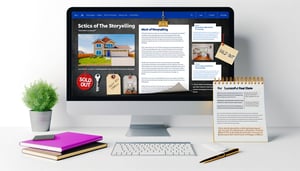In the competitive world of real estate, standing out from the crowd requires more than just listing features and prices. It's about capturing hearts and minds, and what better way to do that than through the timeless art of storytelling?
Compelling stories have the power to:
- Connect with readers emotionally, building trust and rapport.
- Make your emails more memorable and stand out from the generic noise.
- Paint a vivid picture of the lifestyle associated with the property.
- Help buyers envision themselves living in the home and creating memories.
So, how do you weave storytelling magic into your real estate emails? Here are some tips:
1. Find the Story in Every Home:
Every property has a unique story waiting to be told. Is it the historic charm of an old Victorian? The modern convenience of a smart home? The peaceful serenity of a rural retreat? Unearth the hidden narrative that makes this home special.
2. Focus on Emotions, Not Just Features:
Instead of dryly listing square footage and amenities, describe the feeling of walking into a sun-drenched kitchen or enjoying a cozy evening by the fireplace. Evoke emotions that resonate with your target audience.
3. Use Personal Anecdotes (When Appropriate):
Share stories about past clients who found their dream homes, overcame challenges, or simply loved living in the neighborhood. This personal touch adds authenticity and builds trust.
4. Highlight Local Gems:
Go beyond the property itself and tell the story of the surrounding community. Mention charming cafes, vibrant parks, or exciting events that contribute to the area's lifestyle.
5. Show, Don't Just Tell:
Complement your stories with high-quality photos and videos that showcase the home's unique features and surroundings. Immerse your readers in the experience.
Remember: Don't be afraid to experiment with different storytelling techniques. Use humor, nostalgia, or even a touch of mystery to keep your readers engaged.
Here's a couple of examples of how you can incorporate storytelling into your emails:
- Subject Line: "From Blank Canvas to Family Haven: See This Home's Transformation!"
- Body: Share the story of how a fixer-upper was lovingly restored into a warm and inviting family home, highlighting the personal touches and memories created within.
- Subject Line: "More Than Just a House: Discover the Story of [Neighborhood Name]"
- Body: Weave together the history, hidden gems, and unique character of the neighborhood, painting a picture of the lifestyle your target audience desires.
By incorporating the power of storytelling into your email marketing, you can transform your messages from bland notifications to captivating narratives that resonate with your audience, ultimately leading to more interest, more leads, and more homes sold.
So, go forth and tell your stories! Your audience is waiting to be captivated.
FAQ:
1. Can you provide some specific "story starters" for different types of properties, to help me find the right angle?Think about what makes each property unique. For a historic home, delve into its past – was it built by a well-known figure in the community? Did it witness any important events in the area? Are there architectural details that tell a story? Do some research and let the home's history be your guide.
For the sleek, modern smart home, imagine the life of a busy professional – emphasize how the automation enhances their lifestyle with automated lighting, their favorite music playing as they walk in, and overall peace of mind. Paint a picture of convenience and ease.
When it comes to a fixer-upper with lots of potential, focus on the transformation! Help potential buyers envision a family personalizing the space, the laughter and love that goes into the renovation, and the "after" that awaits their creative efforts.
For a cozy cottage, think warmth and simple pleasures. Talk about walking to a nearby bakery or relaxing in the garden. Create a sense of contentment and connection within the community.
2. How do I balance storytelling with the need to provide factual property information?Think of your email like a well-crafted photo – the story is the captivating subject, while the details are the frame that grounds the image. Start with a short, impactful story to hook the reader. This could be a snippet about the house or neighborhood, a bit about a previous happy homeowner, or a vivid description of the space. Then, transition smoothly into a clear and concise list of the property's key features like square footage, number of bedrooms, and amenities. Close your email with a call to action – encourage them to learn more, schedule a showing, or simply contact you for further information.
3. Are there any storytelling techniques to be sensitive to, especially in terms of fair housing and avoiding assumptions about buyers?It's crucial to craft inclusive and welcoming stories. When describing a home, talk about its universally appealing aspects – a layout perfect for entertaining, a peaceful backyard, or proximity to great schools and parks. Steer clear of storylines that might lead a reader to assume the lifestyle, family status, or background of the previous owners or ideal buyers. Let the property itself, and the potential it offers to all kinds of buyers, be the true star of your story.



